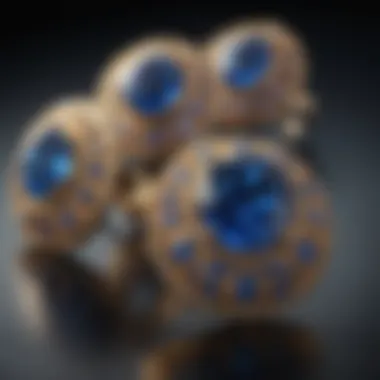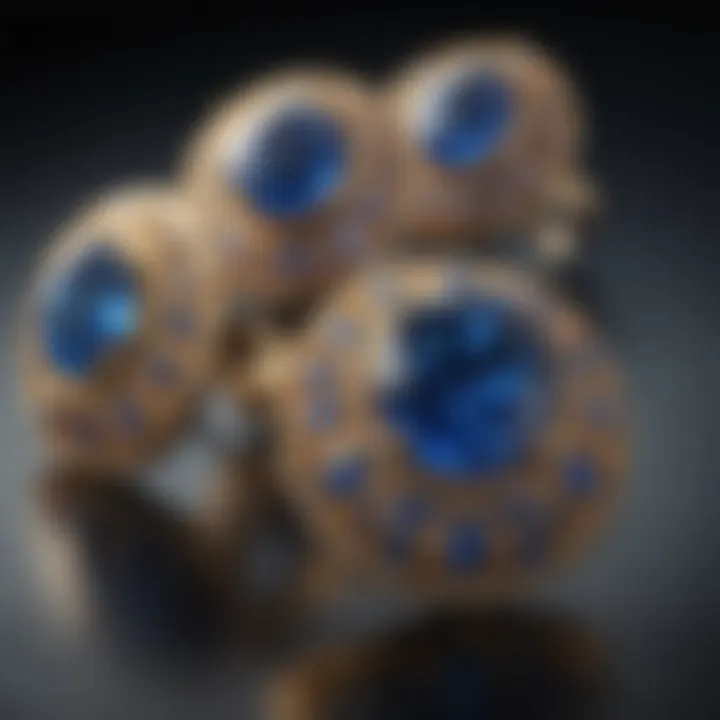The Enigmatic Allure of Colored Sapphires


Intro
Colored sapphires have captivated gem enthusiasts and collectors for centuries. These gemstones, which belong to the corundum mineral family, are not only visually stunning but also rich in history and significance. Their diverse color spectrum ranges from deep blues to vibrant pinks, greens, and even yellows. Understanding the complexity of colored sapphires involves exploring their origins, properties, and cultural implications.
In this article, we will uncover the different aspects of colored sapphires. From their geological formation to their practical applications in jewelry design, each section will provide a deeper insight into these remarkable stones. As we navigate through their characteristics, market trends, and authenticity issues, the aim is to enhance your knowledge and appreciation of colored sapphires.
Gemstone Overview
Definition and Origins
Colored sapphires, a variety of corundum, can be found in nearly every color of the rainbow. The gem derives its color from trace elements during its formation in metamorphic rocks. For instance, iron and titanium can create blue sapphires, while chromium contributes to the formation of pink sapphires. The presence of different elements ultimately determines the gemstone's final hue and quality.
Sapphires form under high heat and pressure deep within the Earth. Typically, they originate in metamorphic or igneous environments, often linked to volcanic activity. Notable sources include places like Sri Lanka, Myanmar, and Madagascar. Each location contributes unique qualities and characteristics, adding layers of complexity to this fascinating gem.
Historical Significance
Historically, colored sapphires have held an important place in various cultures. In ancient China, colored sapphires symbolized nobility and wisdom. In the Middle Ages, they were thought to protect the wearer from envy and harm. Furthermore, colored sapphires have been used in royal jewelry throughout the ages, often signifying power and wealth.
The famous Star of India, a blue sapphire weighing 563 carats, is an example of how these gems have captured the public's imagination. Its history and lore further enhance the appeal of colored sapphires, attracting collectors and enthusiasts alike.
Gemstone Properties
Hardness and Durability
Colored sapphires are renowned for their hardness, rated at 9 on the Mohs scale. This remarkable durability makes them suitable for everyday wear, unlike softer gemstones that may scratch or chip easily. Their toughness ensures they maintain their beauty over time, making them a practical choice for engagements and other significant occasions.
Color and Clarity
The allure of colored sapphires lies primarily in their color and clarity. Colors are evaluated based on hue, tone, and saturation. A vivid, well-saturated color is generally more desirable. Clarity, an essential factor in gemstone evaluation, refers to the presence of inclusions or blemishes within the sapphire. Less visible or absent inclusions tend to yield higher value.
"The combination of vibrant color and high clarity is what makes colored sapphires particularly sought after in the jewelry market."
Preamble to Colored Sapphires
Colored sapphires hold a remarkable position in the world of gemstones. Their variety and appeal make them a favorite among collectors and jewelers alike. Understanding colored sapphires offers insight into their unique attributes, historical relevance, and market trends. This section lays the groundwork for appreciating the depth and complexity of these gemstones.
Defining Sapphires
Sapphires are a type of corundum, which is primarily composed of aluminum oxide. The gemstone is typically known for its striking blue hue, yet it actually exists in a range of colors. The colors are due to trace elements present during formation. For example, iron and titanium can create blue sapphires, while chromium results in pink and red shades. Color is the defining characteristic, making sapphires distinct from other gemstones.
Key characteristics of sapphires include:
- Hardness: Sapphires are rated 9 on the Mohs scale, making them incredibly durable.
- Clarity: The best-quality sapphires are transparent with minimal inclusions.
- Luster: Sapphires exhibit a vitreous luster, adding to their beauty.
Historical Context
Throughout history, colored sapphires have been cherished for their beauty and symbolism. Ancient civilizations, including the Persians and Greeks, believed sapphires had protective qualities and were associated with nobility. The gemstone has appeared in royal crowns and valuable jewelry throughout Europe and Asia.
The popularity of sapphires surged in the 19th century, especially with the arrival of the famous Kashmir sapphires. These stones, known for their enchanting deep blue color, revolutionized the market. Today, sapphires are not only found in royal collections but also in modern jewelry designs, continuing to enchant new generations.
"Sapphires have been symbols of wisdom, loyalty, and nobility throughout the ages."
Understanding both the definition and historical significance of colored sapphires enriches our appreciation for these beautiful stones. Their journey from the earth to adornments reflects human culture, aesthetics, and the persistent allure of nature.
Geological Formation of Colored Sapphires
Understanding the geological formation of colored sapphires is crucial to appreciate their unique characteristics. This knowledge not only intrigues gemstone enthusiasts but also helps collectors and jewelry designers make informed decisions. Different mineral compositions and formation processes contribute to the various hues and qualities of sapphires. In this section, we will explore these elements and consider their implications on value and authenticity.
Mineral Composition
Sapphires are a variety of the mineral corundum, composed primarily of aluminum oxide (Al2O3). The fascinating part is that the presence of trace elements forms the different colors we see in sapphires. For instance, iron and titanium combined yield the classic blue sapphire. In contrast, chromium is responsible for pink and red hues. Some other notable trace elements include:
- Iron: Contributes to blue and yellow tones.
- Vanadium: Enhances color intensity in purple sapphires.
- Magnesium: Can produce green tones in some sapphires.
Understanding mineral composition allows one to differentiate between genuine sapphires and treated or synthetic alternatives. Some treatments aim to enhance color depth through the introduction or modification of these minerals. Recognizing these compositions can significantly impact both appreciation and investment value.
Formation Process
The formation process of sapphires plays a significant role in their rarity and overall quality. Sapphires typically form under high-pressure, high-temperature conditions within the Earth's crust. The key stages of sapphire formation include:


- Metamorphic Processes: In this phase, existing minerals undergo transformation due to heat and pressure, leading to the development of corundum crystals. Regions rich in aluminum-bearing minerals are especially conducive to sapphire formation.
- Igneous Events: Sapphires can also form from molten rock that cools slowly. As this rock solidifies, corundum crystals develop. This often results in larger, higher-quality specimens.
- Transport and Deposition: Erosion and weathering can transport sapphires, leading to alluvial deposits. These stones may vary in quality due to their history of movement and environmental exposure.
It’s essential to understand these processes to ascertain the gemological significance and authenticity of sapphires. Each sapphire's origin can indicate quality characteristics that appeal to collectors and enthusiasts. Gemstones that have undergone natural processes often possess unique features, making them more valuable in the gemstone market.
Color Varieties of Sapphires
The realm of colored sapphires is not just an area of aesthetic beauty; it forms a critical part of what defines these precious stones. Understanding the variety of colors in sapphires exposes their uniqueness and allure, which is essential for gemstone enthusiasts, collectors, and jewelry designers. Each color stems from different trace elements, which contributes to the gemstone's overall characteristics. In this section, we will explore the key color categories and their significance in the marketplace and culture.
Classic Blue
Classic blue sapphires are perhaps the most recognized variety of this gemstone. The rich, deep blue hue is often associated with royalty and luxury, making it a popular choice for engagement rings and other fine jewelry. The color is primarily caused by the presence of iron and titanium within the corundum structure. Over the years, the demand for blue sapphires has surged, especially in modern jewelry design. They symbolize wisdom and nobility, and are believed to bring protection to their wearer.
"Fine-quality blue sapphires can rival diamonds in terms of brilliance and popularity."
Classic blue sapphires are often categorized by their saturation and tone. A more saturated blue can often demand a higher price. Additionally, inclusions can affect the clarity and value of these stones significantly.
Pink and Purple
Pink and purple sapphires add a romantic and whimsical aspect to the colored sapphire spectrum. These varieties are less common than blue sapphires but are rapidly gaining popularity due to their enchanting shades. Pink sapphires can range from a pale blush to a vivid raspberry, while purple sapphires can show various hues from lavender to deep violet.
The vibrant colors in pink and purple sapphires result from a mix of chromium and iron. The deeper the color, the more valuable the stone tends to be. These sapphires appeal to those looking for unique engagement rings or statement pieces. Their allure is not only in aesthetics but also in their rarity.
Yellow and Green
Yellow and green sapphires are often intriguing to collectors and jewelry makers alike. These sapphires exhibit a refreshing range of tones that can enhance a variety of jewelry styles. Yellow sapphires can manifest as bright, cheerful gems due to the inclusion of iron, producing a spectrum from light yellow to canary yellow.
Conversely, green sapphires derive their alluring shades from the presence of iron. They often range from pale green to deep olive shades. While generally not as popular as classic blue or pink varieties, these sapphires can be substantial options for those desiring something different. They often offer better price points compared to their more popular counterparts and can be used creatively in modern designs.
Colorless Sapphires
Colorless sapphires, while less discussed, possess their own charm. These stones are actually a form of corundum that lacks any chromophore, making them transparent. They are highly valued for their clarity and can be a fantastic diamond substitute. Many appreciate colorless sapphires for their versatility as they can complement any jewelry design without overtaking the piece.
These stones are equally durable and can withstand daily wear, making them suitable for various jewelry uses. Their less vibrant appearance can also appeal to minimalist designs that favor subtle elegance. In an era where unique choices are celebrated, colorless sapphires are quietly crafting their own market niche.
Cultural Significance of Colored Sapphires
Color sapphires, revered for their beauty and rarity, hold a rich cultural significance that spans centuries and civilizations. From ancient cultures to modern societies, these gemstones have symbolized various virtues and values. Understanding their cultural role enhances appreciation for colored sapphires beyond their mere aesthetic appeal.
Symbolism in History
Throughout history, colored sapphires have symbolized wisdom, nobility, and divine favor. The ancient Greeks associated sapphires with Apollo, the god of wisdom and light, believing that wearing these stones would grant one insight and mental clarity. In medieval Europe, the clergy wore sapphires to symbolize heaven and purity. The deep blue hue of sapphires was often seen as a representation of the divine, connecting the wearer to celestial wisdom.
In the context of royalty, colored sapphires became synonymous with power and authority. Kings and queens adorned themselves with sapphire jewelry, believing that the gemstone protected them from harm and envy. Interestingly, the blue sapphire has also been linked to the concept of loyalty. In many cultures, it was offered as a token to affirm fidelity and trust within relationships.
"In the past, colored sapphires were believed to have protective qualities against poison, making them highly sought after by the aristocracy and merchants alike."
Sapphires in Different Cultures
Colored sapphires have unfolded numerous narratives across different cultures. In Asia, specifically in countries like Thailand and Myanmar, sapphires are integral to local traditions. Thai artisans have crafted stunning sapphire jewelry for generations, viewing sapphires as symbols of prosperity and good fortune. Here, it is common to see brilliant blue sapphires set in intricate pieces, often incorporated into wedding traditions.
In contrast, in some African cultures, colored sapphires like yellow and green are viewed as stones of healing. They are believed to have therapeutic effects, aiding mental and physical well-being. Similarly, in Hinduism, sapphires are regarded as sacred. Wearing a sapphire, particularly a blue one, is thought to invoke the blessings of ancestors and deities.
Furthermore, the rise of global trade has also influenced the significance of sapphires. As colored sapphires became more accessible, they have transitioned into modern jewelry, often personalized to reflect individual style while retaining their historical significance. From engagement rings to statement pieces, sapphires continue to symbolize love, honor, and commitment today.
Understanding the cultural significance of colored sapphires helps one recognize their multifaceted roles across time and societies. They elevate beyond a mere gem; they embody stories, beliefs, and traditions that have enriched human experience.
Treatment and Enhancement Techniques
Treatment and enhancement of colored sapphires is a crucial aspect of understanding these gemstones. These processes can greatly affect the appearance, value, and marketability of sapphires. They also raise important considerations regarding authenticity and ethical sourcing. For enthusiasts, collectors, and jewelry designers, it's beneficial to understand how these treatments can alter the natural properties of sapphires. This knowledge aids in making informed decisions when purchasing or designing with these stones.
Heating
Heating is one of the most common treatments applied to colored sapphires. This process alters the crystal structure to enhance the stone's color and clarity. Natural sapphires usually exhibit color zoning, which can detract from their beauty. Through heating, these color variations can be minimized, resulting in a more uniform appearance.
Most blue sapphires on the market have undergone this treatment, especially when sourced from regions like Sri Lanka or Thailand. The process is generally considered acceptable in the industry, but buyers should always inquire about the origins and treatment history of the stone. Well-heated sapphires can exhibit rich and vibrant colors, making them highly desirable.
Diffusion
Diffusion treatment is another method that has gained traction in the colored sapphire market. This process involves applying heat alongside chemical elements, such as beryllium, to enhance the stone's color on the surface. The result can be a stone that appears significantly more vivid than its untreated counterpart.


While diffusion can produce stunning results, it also presents ethical questions. The surface color can sometimes fade over time, especially if the sapphire is not properly cleaned or maintained. Therefore, it is imperative for buyers to ensure they are aware of any diffusion treatments. This knowledge impacts transparency and can influence investment value in the long term.
Synthetic Sapphires
Synthetic sapphires are created in laboratories and can mimic the appearance of natural sapphires quite convincingly. The production process allows for control over the color, clarity, and size of the stones, making them an attractive option for many consumers. They are often more affordable than their natural counterparts, which can make them tempting choices for jewelry makers or collectors on a budget.
However, distinguishing between synthetic and natural sapphires can be challenging without scientific testing. Many individuals prefer natural stones for their rarity and perceived value. Moreover, the rise of synthetic sapphires raises concerns about their impact on market dynamics, potentially affecting the prices of natural colored sapphires. Customers and designers should be aware of the type of sapphire they are acquiring and the implications of its origin.
Understanding treatment techniques is essential for buyers and collectors who want to ensure they invest in quality gemstones.
In summary, treatments such as heating, diffusion, and the emergence of synthetic sapphires play significant roles in the colored sapphire market. Each method produces distinct outcomes that can vary in quality and authenticity. Knowing the specifics of these processes enhances the experience of enthusiasts, helping them make well-informed choices in their pursuit of colored sapphires.
Identifying Authentic Colored Sapphires
The ability to identify authentic colored sapphires is crucial in the gemstone market. As the demand for these striking gemstones increases, so do the opportunities for counterfeits and synthetic alternatives. Buyers need to be equipped with knowledge to discern genuine sapphires from imitations. Authenticity affects not only the value of the gemstones but also their quality and overall appeal in both personal collections and commercial markets.
Recognizing the key features that define real colored sapphires can prevent buyers from making uninformed purchases. This section aims to address the importance of inclusions and clarity, and color zoning. These characteristics serve as the foundation for identifying genuine sapphires.
Inclusions and Clarity
Sapphires are unique, and their clarity can reveal much about their authenticity. Inclusions, which are internal features found within gemstones, can provide indication of a sapphire's origin and treatment history. Unlike synthetics or treated stones, authentic sapphires might contain natural inclusions such as rutile needles or silk, which contribute to their identity.
Evaluating the clarity of a sapphire involves not just looking for a clean appearance but understanding that some inclusions are acceptable. Here are key points regarding inclusions and clarity:
- Visual Inspection: Using a loupe or microscope can uncover inclusions. A gemstone without any inclusions may not be genuine, as high-quality natural gems often possess internal features.
- Common Inclusions: Some inclusions often found in natural sapphires include silk, fingerprints, and gas bubbles. Not all inclusions decrease value; some can enhance it by indicating authenticity.
- Clarity Grade: GIA (Gemological Institute of America) provides clarity grading systems. Familiarity with these can help buyers assess the worth and authenticity of sapphires.
"Sapphires with visible inclusions may sound less appealing, but they often tell a story of formation and authenticity."
Color Zoning
Color zoning refers to the presence of different colors within a single sapphire. This feature can be a critical indicator of authenticity, as natural sapphires often exhibit color variation due to differences in mineral composition during their formation. Synthetic stones typically lack this zoning, appearing overly uniform.
Understanding color zoning can be beneficial in the following ways:
- Natural Look: Color zoning can add depth and character to a sapphire, rather than detracting from its beauty.
- Genuine Variability: Natural sapphires can display color bands, which a trained observer can spot. Recognizing these variations can help determine if a sapphire is real or a synthetic copy.
- Market Value Insight: Zoning can influence the price. In some cases, more complex color patterns can increase a sapphire's desirability and market value.
In summary, identifying authentic colored sapphires involves more than simply looking for a visually appealing gem. It is a blend of understanding inclusions, clarity, and color zoning, providing valuable insights into a gemstone's authenticity and potential value.
Market Trends and Values of Colored Sapphires
Understanding the market trends and values of colored sapphires is crucial for anyone involved in the gemstone industry, whether as a collector, designer, or investor. These trends provide insights into consumer preferences, pricing fluctuations, and overall market health. As colored sapphires continue to gain popularity, it becomes imperative to understand the forces shaping their market dynamics.
Current Market Dynamics
The colored sapphire market has seen notable changes over recent years. Factors influencing current dynamics include:
- Consumer Demand: There is a growing interest in colored sapphires over traditional diamonds. Buyers are increasingly seeking unique stones that reflect personal style.
- Supply Chain: The availability of ethically sourced sapphires has impacted pricing. Increased awareness of sustainability has led consumers to prefer gemstones that support fair labor practices.
- Geographical Influence: Regions known for high-quality colored sapphires, such as Sri Lanka and Thailand, affect global prices due to regional demand and limited supply.
In addition to geographical factors, technology also plays a role. Online platforms have made it easier for buyers to access a broader selection, influencing competition among sellers and potentially lowering prices.
Investment Potential
Investing in colored sapphires presents both opportunities and challenges. Several key points stand out:
- Rarity and Value Preservation: Natural colored sapphires, especially those with desirable hues and high clarity, can appreciate significantly in value over time. Investors often consider these as a hedge against inflation.
- Market Volatility: Like all gemstones, colored sapphires can be subject to market fluctuations. Factors such as economic downturns or changes in consumer trends can impact prices.
- Research Importance: Prospective investors should research specific varieties and their market history. For instance, intense blue sapphires often command higher prices than their lighter counterparts.
"Investing in colored sapphires requires careful consideration of both emotional value and market trends."
Care and Maintenance of Colored Sapphires
Proper care and maintenance of colored sapphires are crucial for preserving their beauty and durability. These gemstones can be an investment, and understanding how to care for them is essential for any enthusiast or collector.
Keeping sapphires clean and storing them in a suitable environment ensures they retain their vibrant colors and clarity. When neglected, sapphires can accumulate dirt and grime, which diminishes their visual appeal. Additionally, improper storage can lead to scratches or damage, undermining their structural integrity. Therefore, it is beneficial to be knowledgeable about best practices for cleaning and storing these precious stones.
Cleaning Methods
Cleaning colored sapphires should be done carefully to avoid any damage. Here are some recommended methods:
- Warm soapy water: Mix gentle dish soap with warm water. Soak the sapphire for about 15 minutes. Use a soft toothbrush to gently scrub around the stone. Rinse thoroughly with clean water.
- Ultrasonic cleaners: These devices use high-frequency sound waves to agitate a cleaning solution, effectively removing dirt. However, not all sapphires are suitable for this method. If the gemstone has been treated, consult an expert first.
- Steam cleaning: This method can be effective but must be used cautiously as it may affect treated stones. A simple handheld steamer can do the job.
- Avoid harsh chemicals: Steer clear of bleach or acid-based cleaners, as they can harm the stone.


Regular cleaning keeps the sapphires looking their best. Establishing a cleaning routine is vital.
Storage Recommendations
Storing colored sapphires properly is just as important as cleaning them. Here are specific recommendations for safe storage:
- Separate from other jewelry: Prevent scratches by keeping sapphires in a fabric-lined box or pouches, separate from other gems especially harder stones like diamonds.
- Avoid direct sunlight: Colored sapphires can fade when exposed to prolonged sunlight. Store them in a cool, dark place.
- Use silica gel packs: This helps to control moisture levels in storage areas, reducing the risk of damage caused by humidity.
- Safety deposit boxes: For valuable pieces, consider utilizing a safety deposit box for maximum protection.
Proper care and storage can significantly enhance the longevity and vibrancy of colored sapphires, maintaining their allure for years to come.
Use of Colored Sapphires in Jewelry
Colored sapphires play a significant role in the jewelry industry. Their allure goes beyond mere aesthetics; they symbolize status, passion, and individuality. Jewelers and designers increasingly favor these gemstones due to their variety of colors and durability. Colored sapphires are not just beautiful; they make versatile pieces usable in various styles and forms of jewelry.
Understanding the use of colored sapphires is essential for gemstone enthusiasts and jewelry collectors. They come in hues that appeal to a wide range of tastes, ensuring that there is a sapphire suitable for every occasion and personal style. Additionally, their hardness, rated at 9 on the Mohs scale, makes them ideal for daily wear, unlike many other gemstones that may scratch or fade over time.
"The range of colors in sapphires beckons creativity in design, pushing jewelers to explore unique applications across the market."
Popular Jewelry Types
Colored sapphires find their place in various types of jewelry. Some of the most popular formats include:
- Engagement Rings: Many couples choose colored sapphires as an alternative to traditional diamond engagement rings. Popular choices include blue, pink, and padparadscha sapphires.
- Earrings: Whether in stud or drop form, colored sapphire earrings can make a bold statement or offer a subtle sparkle.
- Necklaces and Pendants: Gemstone necklaces featuring colored sapphires can be both elegant and striking. Designers often use them in multi-gem pieces.
- Bracelets: Sapphires can add notable color to bangles or charm bracelets, making them visually appealing.
These types of jewelry make it easy for people to incorporate colored sapphires into their wardrobes. The range of colors and designs often dictates the popularity of specific pieces, influenced by trends, cultural significance, and personal taste.
Customization Options
Today’s consumers seek personalized experiences, and the jewelry market has adapted accordingly. Customization of jewelry featuring colored sapphires allows individuals to express their unique styles. Options to consider include:
- Setting Styles: Buyers can choose from various settings, such as solitaire, halo, or cushion designs, based on preference.
- Cut Variations: Different cuts can enhance the brilliance of a sapphire, such as round, oval, or pear-shaped.
- Metal Choices: Options range from classic yellow gold to contemporary white gold and platinum, allowing for further personalization.
- Mixed Gemstone Designs: Combining sapphires with other gemstones can create a one-of-a-kind piece. This blend not only affects color but also the overall aesthetic.
Customization options allow buyers to acquire jewelry that not only features colored sapphires but is also a reflection of their individual taste and style.
Ethical Considerations in Sourcing
The sourcing of colored sapphires has significant implications for both the environment and society. Understanding the ethical considerations behind their extraction is essential for consumers and industry professionals alike, as these aspects impact the perception, value, and future of these gemstones. Ethical sourcing focuses on the ramifications of mining practices, the treatment of workers, and the sustainability of the environment.
The role of ethical considerations in sourcing colored sapphires cannot be overstated. As the demand for colored sapphires continues to rise, it becomes increasingly important to ensure that gemstones are obtained in a manner that minimizes environmental degradation and promotes fair labor practices. Responsible sourcing not only safeguards the ecosystems where sapphires are mined but also fosters economic and social development in local communities.
Sustainable Practices
Sustainable practices in the mining of colored sapphires emphasize the importance of preserving the environment while also ensuring that mining operations are equitable. Sustainable mining techniques aim to reduce the carbon footprint and protect biodiversity. This can include:
- Minimizing Land Disruption: Employing selective mining methods reduces the overall disturbance to the land. By choosing smaller-scale operations that focus on specific deposits, the impact on natural habitats can be mitigated.
- Water Management: Efficient water management practices help prevent contamination of local water sources, which is crucial for the surrounding communities.
- Supporting Local Economies: By prioritizing local workers and ensuring fair wages, companies can contribute to the economic stability of mining regions, promoting community growth and development.
Incorporating these principles leads to a more robust and resilient market for colored sapphires, where consumers can trust that their purchases support environmentally and socially responsible practices.
Fair Trade Certifications
Fair Trade certifications play a crucial role in ensuring that colored sapphires are responsibly sourced. These certifications indicate that the gemstones have been mined under strict labor standards and environmental regulations. The benefits of fair trade practices include:
- Labor Rights: Fair Trade ensures that miners receive fair wages, safe working conditions, and are free from exploitation. This promotes dignity and respect for all workers in the supply chain.
- Environmental Standards: Certification processes often require adherence to sustainability standards, which help protect the surrounding environment.
- Transparency: Fair Trade practices encourage transparency in the mining process, allowing consumers to trace the origins of their gemstones, leading to more informed purchasing decisions.
By choosing Fair Trade certified sapphires, consumers can actively support ethical initiatives, which not only help protect the environment but also uplift miners and their communities.
Ethical sourcing and transparency are paramount in fostering trust between producers and consumers, ensuring a future where colored sapphires contribute positively to the world.
Closure: The Enduring Appeal of Colored Sapphires
The exploration of colored sapphires encapsulates a rich tapestry of history, culture, and scientific intrigue. By understanding their geological formation and the various color variants, buyers and enthusiasts can appreciate why these gemstones are coveted throughout the world. The unique properties and enduring beauty of colored sapphires often lead to their classification as a worthwhile investment. Beyond mere aesthetics, the emotional and cultural significance tied to these gems renders them even more compelling.
One cannot overlook the impact of ethical considerations surrounding the sourcing and trade of sapphires. With a market increasingly focused on sustainability and fair trade, there is a growing demand for responsibly sourced gemstones. This shift not only enhances the overall appeal of sapphires but also aligns with the values of modern consumers who prioritize ethics alongside quality. This dual focus on aesthetics and ethics ensures that colored sapphires will remain relevant in the luxury market.
Future Trends
As we look to the future, the market for colored sapphires is poised for evolution. The rising interest in bespoke jewelry is likely to spur innovative designs. Jewelers may increasingly leverage colored sapphires in unique pieces that reflect personal stories and tastes. Additionally, synthetic sapphires are gaining ground due to their availability and lower prices. However, the artisanal craftsmanship tied to natural stones will sustain their allure among traditionalists.
Technological advancements also play a role in shaping the market. Enhanced non-invasive testing methods will empower consumers to verify the authenticity of sapphires without compromising the distinct characteristics of each stone. This not only safeguards buyers but promotes transparency in the industry overall.
"The future of colored sapphires lies at the intersection of art, science, and ethical responsibility."
Final Thoughts
As consumer preferences continue to evolve, so will the desirability of colored sapphires. The ongoing interplay of tradition and innovation within the gemstone industry promises a bright future. Engaging with colored sapphires goes beyond ownership; it is about participating in an age-old narrative that celebrates beauty, meaning, and integrity.



